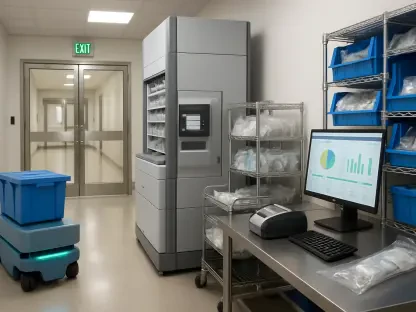In a landscape where wearable technology often prioritizes fitness and general wellness, a significant gap has persisted in addressing the nuanced needs of women’s reproductive health, leaving many users searching for tools that truly understand their unique physiological journeys. Oura, a pioneer in smart ring technology, has stepped into this void with groundbreaking features aimed at revolutionizing how women monitor and manage critical life stages. With the recent launch of an enhanced Pregnancy Insights tool alongside a pioneering Perimenopause Check-In, the company is not only filling a crucial market gap but also setting a new benchmark for personalized health tracking. These innovations underscore a growing recognition within the tech industry that women’s health demands more than just surface-level tracking—it requires depth, data, and empathy. This development marks a pivotal moment, as Oura positions itself as a leader in a space where competitors have yet to fully catch up, promising a future of more inclusive health technology.
Revolutionizing Pregnancy Monitoring
Oura’s Pregnancy Insights feature represents a significant leap forward in how expectant mothers can track their health with precision and context. Unlike basic tracking tools that merely log milestones, this enhanced functionality offers continuous monitoring of vital biometrics such as temperature trends, resting heart rate, heart rate variability, and respiratory rate throughout the entire pregnancy. Drawing on data from thousands of pregnancies, it provides trimester-specific comparisons and full-term reference ranges, ensuring users receive tailored insights. Beyond raw data, the tool includes symptom tagging and a calibration period for new users, making it accessible even to those unfamiliar with wearable tech. Importantly, Oura emphasizes that this feature is a complement to prenatal care, not a replacement, offering real-time context between medical visits. Supported by expert-backed educational resources, it empowers users with knowledge to better understand their bodies during one of life’s most transformative experiences.
This focus on detailed, personalized monitoring sets Oura apart in a market where pregnancy tracking often feels like an afterthought. Many competing platforms limit their offerings to logging key dates or basic fertility insights, lacking the depth of continuous biometric analysis that Oura provides. The inclusion of educational content further enhances the tool’s value, helping users interpret complex data in a meaningful way. Additionally, the opt-in nature of the feature ensures privacy, allowing individuals to control how much data they share or track. This thoughtful design addresses a common concern in health tech, where sensitive information can feel vulnerable. By blending cutting-edge technology with user-centric features, Oura not only supports expectant mothers but also builds trust, a critical factor in the adoption of such intimate tools. As a result, this innovation could redefine expectations for how wearable devices support women through pregnancy, pushing the industry toward more comprehensive solutions.
Addressing Perimenopause with Innovation
Equally transformative is Oura’s Perimenopause Check-In, a feature that tackles a phase of life often ignored by digital health tools, despite affecting over a billion women globally in perimenopause or post-menopause. This pioneering tool employs the clinically validated Menopause Rating Scale to assess symptom severity, integrating biometric and cycle data to create detailed reports that users can share with healthcare providers. Such integration facilitates informed clinical conversations, bridging the gap between self-tracking and professional care. Accompanied by educational materials and real-life user stories, the feature aims to demystify perimenopause, providing a non-invasive alternative to traditional diagnostic methods like blood tests. This approach not only makes support more accessible but also normalizes discussions around a life stage that many experience in silence, fostering a sense of community and understanding.
The significance of this tool cannot be overstated, as the wearable tech industry has historically overlooked perimenopause in favor of more commonly addressed areas like menstrual tracking. Oura’s initiative stands out as one of the first mainstream, ring-based platforms to offer such targeted support with clinical validation. While niche devices exist for this demographic, they often lack the comprehensive monitoring capabilities of Oura’s ecosystem. The feature’s design, which prioritizes ease of use and scalability, ensures that users at varying levels of tech familiarity can benefit from its insights. Furthermore, the opt-in privacy controls reflect a commitment to user autonomy, addressing a critical concern in health data management. By focusing on an underserved population with a blend of technology and empathy, Oura is paving the way for broader industry recognition of women’s health needs across all life stages, potentially inspiring competitors to follow suit with equally innovative solutions.
Standing Out in a Competitive Landscape
In the crowded wearable tech market, Oura’s latest features position it as a formidable player against giants like Apple and Samsung, as well as specialized platforms like Whoop and Natural Cycles. While many competitors offer menstrual and fertility tracking, their tools often focus on milestone logging rather than the continuous, detailed biometric analysis that Oura provides for pregnancy. Similarly, perimenopause support remains virtually absent from mainstream offerings, giving Oura a unique edge with its clinically validated Check-In feature. Even as some brands have recently ramped up efforts in reproductive health, their approaches lack the specificity and depth seen in Oura’s dual focus on distinct life stages. This gap highlights a broader industry trend: women’s health needs are only beginning to gain the attention they deserve, and Oura is leading the charge with tools that prioritize nuance over generalization.
Beyond feature comparison, Oura’s commitment to bridging self-tracking with clinical relevance sets a high standard for what wearable tech can achieve. The emphasis on educational resources alongside data-driven insights ensures users are not just collecting information but understanding its implications for their health. Privacy controls further enhance its appeal, addressing a growing demand for transparency in how personal data is handled. As these tools roll out globally, with Pregnancy Insights already available and Perimenopause Check-In expanding internationally by year-end, Oura is poised to influence how competitors design future health features. This strategic focus on comprehensive reproductive health monitoring suggests a shift in the industry, where wearable devices evolve from mere fitness trackers to holistic health companions. Such progress could ultimately reshape user expectations, pushing the market toward more inclusive and personalized technology solutions.
Pioneering a Healthier Future
Reflecting on Oura’s strides, it becomes clear that the company has taken bold steps to address critical gaps in women’s health technology with tools that are both innovative and deeply practical. The enhanced Pregnancy Insights provides expectant mothers with unprecedented access to continuous biometric data, empowering them with insights between medical visits. Simultaneously, the Perimenopause Check-In breaks new ground by offering support for a life stage long neglected by digital health, using validated assessments to foster informed care. These advancements not only distinguish Oura from competitors but also set a precedent for what wearable tech can achieve when tailored to specific needs. Looking ahead, the challenge lies in maintaining this momentum—ensuring accessibility and scalability while inspiring other companies to prioritize underrepresented health areas. Continued focus on privacy and education will be key, as will adapting to user feedback to refine these tools, ultimately driving a future where technology truly serves every stage of life.









